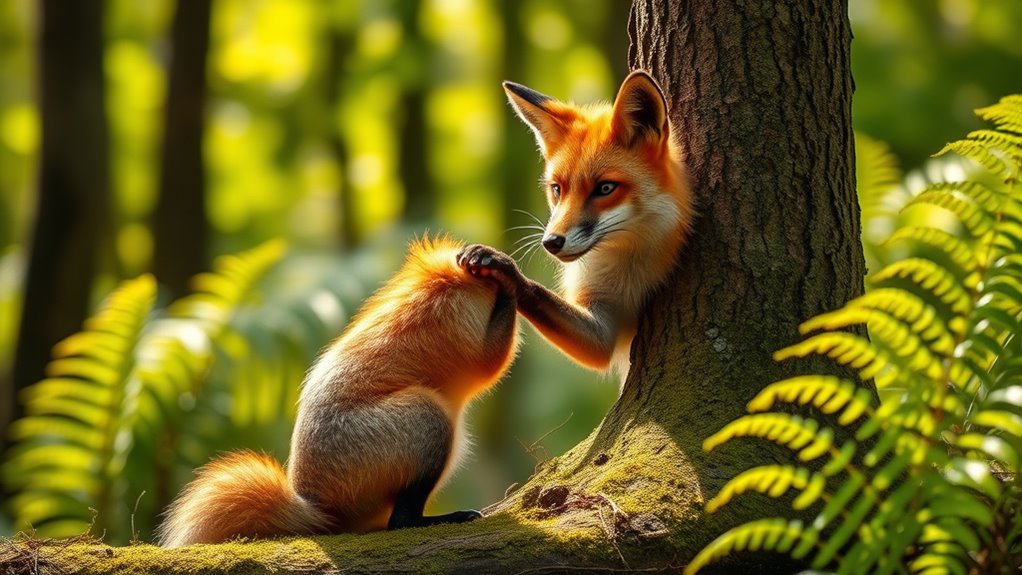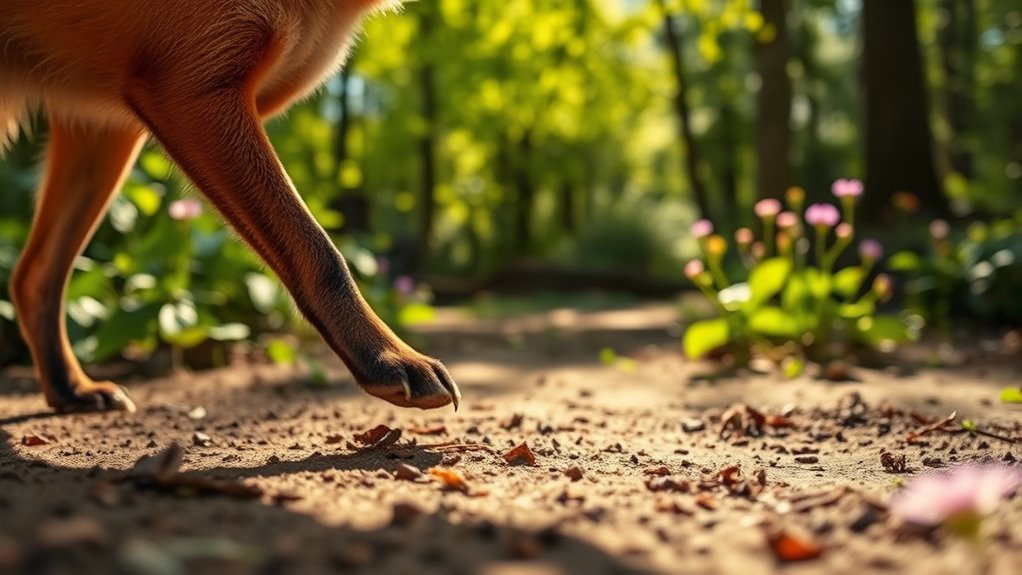Scent marking is a vital communication method for animals. It helps them declare territory, signal their identity, and share health status. During mating seasons, both males and females use keen scents to attract partners and assert dominance. These unique chemical signals can even shape social hierarchies within communities. By monitoring scents, animals can navigate their environments and detect potential threats. There’s much more to discover about how these scents function and impact animal behavior.
Key Takeaways
- Scent marking communicates territory boundaries and establishes claims among animals, creating invisible markers in their environment.
- Animals use scent to convey reproductive signals, with females emitting pheromones to indicate fertility and attract mates.
- The chemical composition of scents varies by species, with distinct odors helping animals identify individuals and assess health.
- Scent marking aids in maintaining social structures, allowing animals to differentiate between friends and rivals within their communities.
- Animals utilize scent trails for environmental monitoring, detecting threats, and navigating their territories efficiently.

Scent marking is a fascinating behavior observed in various animals, where they use chemical signals to communicate and establish territory. When you think of animals marking their territory, you might picture a dog lifting its leg against a tree. But it’s much more complex than that. Each creature, from cats to rodents, has its own unique way of laying down scent markers, creating invisible lines that define their territorial boundaries. These scents are packed with information, telling other animals who belongs in the area, what’s going on, and even their health status.
Scent marking intricately communicates territory and status among animals, revealing a complex world beyond simple behaviors.
As you explore more deeply into this behavior, you’ll realize that scent marking serves multiple purposes beyond just establishing territory. For many species, it’s also a way to convey reproductive signals. When animals are ready to mate, they often enhance their scent marking to attract potential partners. You might notice that during mating season, the air is filled with more potent odors as females signal their readiness and males assert their dominance. This olfactory communication is vital for ensuring the continuation of their species.
In various species, the chemical composition of the scent can vary drastically. For instance, a female cat in heat emits pheromones that are almost irresistible to male cats, alerting them to her availability. You can imagine how this strategy gives her an advantage in the mating game. By marking her territory with distinct reproductive signals, she not only attracts mates but also wards off rivals who might want to encroach on her space. The balance of these scents creates a dynamic social structure within animal communities.
Moreover, scent marking is a way for animals to monitor their environment. When you see a fox sniffing around its territory, it’s not just checking for food; it’s also evaluating the scents left by other animals. This information helps it stay aware of potential threats or competitors. By understanding these scent trails, animals can navigate their territory more effectively.
Frequently Asked Questions
What Types of Animals Use Scent Marking?
Many animals, including mammals like wolves, cats, and rodents, use scent marking to establish territorial boundaries. You might notice that they leave their scents on trees, bushes, or the ground. This behavior not only communicates their presence but also acts as a predator deterrence, warning others to stay away. Birds and reptiles also engage in similar practices, ensuring they maintain control over their space while avoiding potential threats.
How Does Scent Marking Differ Among Species?
Scent marking differs among species in how they communicate chemical signals and establish territorial boundaries. For instance, wolves use urine to mark territory, signaling to others about their presence. In contrast, cats may use pheromones from their cheeks to communicate familiarity or mating readiness. Each species tailors its scent marking to its environment and social structure, ensuring effective communication and maintaining boundaries in a way that suits its unique needs.
Can Scent Marking Affect Animal Behavior?
Yes, scent marking can markedly affect animal behavior. When you mark your territory, you establish boundaries that deter rivals and maintain order within your environment. This behavior helps you avoid confrontations and potential conflicts. Additionally, scent marking can signal your presence to potential predators, allowing you to avoid dangerous encounters. By communicating through scents, you not only define your territory but also enhance your chances of survival in the wild.
Is Scent Marking Used During Mating Seasons?
Yes, scent marking plays a vital role during mating seasons. Imagine the air thick with the earthy aroma of musk, as males stake their claim, signaling their presence to potential mates. This fragrant language not only attracts females but also warns rivals, igniting territorial disputes. With each scent, you create a vivid map of your territory, helping to deter predators and guarantee your lineage continues in the wild’s intricate dance of survival.
How Do Environmental Factors Influence Scent Marking?
Environmental factors markedly influence scent marking. When you consider temperature and humidity, you realize they can affect how long scents last, impacting territorial boundaries. In areas with high predator presence, animals might mark more frequently to signal their territory and deter intruders. You’ll notice that during changes in weather or habitat, animals adjust their scent-marking behavior to guarantee effective communication and enhance predator detection, helping them stay safe and assert their dominance.
Conclusion
In the grand theater of nature, scent marking’s the dazzling spotlight that animals use to communicate their most secret thoughts and desires. Imagine the forest alive with invisible messages, each whiff a dramatic tale of territory, love, or warning—a fragrant symphony played by creatures both big and small. It’s as if every bush and tree is a page in an epic saga, where the air is thick with stories just waiting for you to breathe them in.









